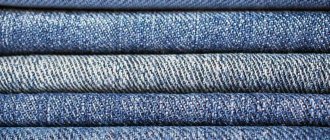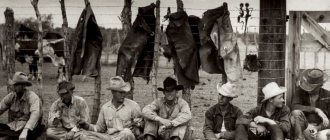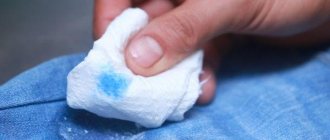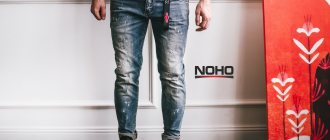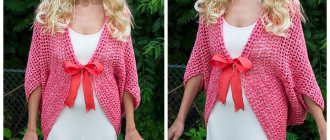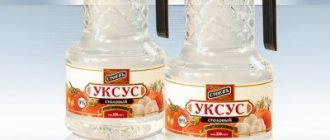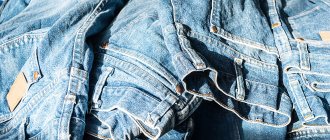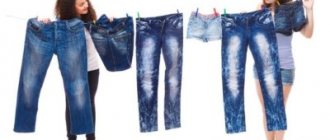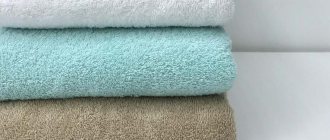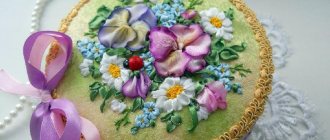Story
The history of jeans began in medieval Europe. French weavers from the city of Nîmes wove thick cotton fabric to make ship sails. The decline of the sailing fleet led to the uselessness of matter, and only a happy accident helped it not to sink into oblivion.
In the mid-19th century, during the gold rush, American businessman Levi Strauss came up with the idea of sewing trousers from denim with pockets for small items, which turned out to be in demand among gold miners because of their convenience and durability.
The addition of copper rivets to trousers, invented by Jacob Davis, allowed the production of jeans to be patented in 1873, which made the fabric popular.
How is denim made?
Making fabric begins with dyeing the main threads. To do this, cotton threads are joined into long ropes using a warping machine. The ropes are wound on bobbins and then passed through boxes of dyes. The dyeing cycle is repeated up to 7-10 times. After dyeing, the ropes are unraveled back into individual fibers from which they are woven into denim.
The traditional dye is dark blue indigo. It is possible to use a dye based on sulfur or other dyes, then denim fabric in blue, black, mustard, gray, and green shades is born.
To increase strength, the fibers are dipped into a container with hot starch and wax. Threads treated in this way do not fray or tear during the weaving process. The finished yarn is dried, wound on a bobbin and sent to the loom.
Types of fabric
Types of denim fabric:
- denim - thick, durable denim made of pure cotton without additives;
- ecru is undyed denim that has the natural color of cotton;
- jean - lightweight budget type jeans, may contain viscose or polyester;
- chambry is a lightweight, thin type of cotton jeans, the weft and warp threads of which are intertwined in a 1:1 ratio;
- stretch - jeans with elastane, tightly fitting the figure.
According to weaving technique, denim is divided into:
- right-hand weaving twill - the direction of the hem is from the lower left corner to the upper right;
- left-hand weave twill - the rib is directed to the left;
- broken twill - the weaving has a herringbone look.
Types of denim fabric are distinguished according to the characteristics of their composition and appearance.:
- vintage - boiled denim with abrasions and bleached areas;
- striped - with stripes woven on the surface;
- designer - decorative jeans, decorated at the request of the designers;
- bonding - jeans combined with a layer of knitwear;
- luxury - fabric with a uniform texture, without a pronounced diagonal scar;
- Silk denim is characterized by a noble surface shine;
- Linen jeans contain 50% cotton and 50% linen, and are distinguished by the presence of knots and seals on the surface;
- insulated jeans with fleece or biker.
Advantages and disadvantages
Denim owes its popularity to a set of inherent positive qualities .
Classic denim:
- consists of natural fibers;
- wear-resistant;
- allows air to pass through;
- absorbs moisture;
- keeps warm;
- not electrified;
- wrinkles little;
- unpretentious in care.
Among the disadvantages of the fabric, it should be noted that it:
- shrinks when washed in hot water;
- wears off over time;
- fades and stains other products.
Advantages and disadvantages of the material
The main advantages of denim:
- Durability. Denim fabric is dense and durable. It does not stretch and does not lose its attractiveness over time. Clothes made from the material can be worn for years.
- Easy to care for. The material practically does not wrinkle. It can be washed in a washing machine. The fabric does not absorb dirt, which allows you to remove almost any stain.
- Versatility. Denim items never go out of style. They are comfortable to wear and can be combined with clothes of any style.
- Comfort. The material is breathable, but at the same time protects well from the cold. It is neither cold nor hot. Does not electrify, absorbs moisture well.
There are also disadvantages:
- The material will shrink after each wash. When worn, it stretches to its original size.
- In areas that are constantly exposed to friction and other mechanical stress (knees, inner thighs, buttocks), the fabric wears out over time.
- After washing, clothes become stiffer.
Care instructions
Following the recommendations indicated on the product label will help extend the service life, maintain the appearance and positive characteristics of denim items.
General recommendations:
- Before washing, you should fasten all buttons, hooks, zippers, and turn the clothes inside out;
- You can wash denim clothes by hand or on a delicate cycle in a washing machine, the water temperature should not be higher than 40 degrees;
- the use of bleach and aggressive washing powders is prohibited;
- It is recommended to wash denim items separately from other items;
- no need to twist or squeeze the product, the water can drain on its own;
- dry things in a well-ventilated area;
- Iron semi-damp jeans from the inside out through the protective fabric, avoiding the formation of creases and wrinkles.
Jeans care
It is easy to care for jeans at home. The fabric can be washed both by hand and in a washing machine.
Washing and drying
Despite the simple care, there are some rules for washing and drying jeans. They are presented in the list:
- It is advisable to wash things at a temperature no higher than 40 degrees. Clothes shrink in hot water. It is used if the material has stretched.
- Jeans should not be washed with clothes of a different color, as they will fade. To reduce shedding, clothes are washed inside out.
- Do not use powders with bleach for washing. They increase shedding.
- Thick jeans can be rubbed, but thin jeans cannot.
- Dry the material in the shade. It is not recommended to fix the fabric with clothespins, otherwise there will be creases that will be difficult to smooth out.
- Do not over-dry or dry at high temperatures. This will make the matter rigid.
To watch a story about washing a product:
How to iron material
The material, which does not contain synthetics, can be ironed at high temperatures. Steamers can be used. The stretch is smoothed out on the body.
See ironing instructions:
Recommendations for use
When choosing a product, you should pay special attention to the quality and composition of the fabric:
- the original denim fabric consists of cotton; if synthetic additives are present, their proportion in the composition should be less than cotton;
- high-quality jeans - thick and heavy;
- the fabric is distinguished by a noticeable diagonal scar on the surface;
- classic denim has a dyed front side and a colorless reverse side; the dye does not leave marks on the hands.
The weight of one meter of denim is approximately 350 grams. High-quality jeans for an adult weigh about 1 kilogram.
Denim goes well with other materials and goes well with decorative fittings.
Jeans fabric: types and varieties
There is more than one type of jeans as a fabric, which differs in composition and coloring. What fabric are jeans made from?
Variety of jeans
Denim
One of the most common fabrics for jeans, it is created by weaving two fibers - white and blue. Because of this, the jeans are blue on the outside and light on the inside. Quite an expensive material, so it is often used for designer products.
Denim products
Jeans - stretch
Description of this fabric: consists of cotton with the addition of spandex or polyester, which allows stretch and fits to the figure. Women's clothes are usually made from stretch.
Chambry
Lightweight cotton fabric, usually worn in summer. Dresses, sundresses and shirts are often made from it.
Ecru
Light-colored cotton fabric is usually white because it is not dyed.
Broken twill
This type of jeans is a fabric with a characteristic herringbone weave and is quite dense.
What does broken twill look like?
Gin
It has a solid blue tint, is inexpensive, quite thin, and made of cotton.
Jeans-silk
Denim fabric, which has its own shine, is smooth.
Also, the quality of the material depends on where the cotton comes from. Therefore, there are these types of cotton for jeans:
- Mexican cotton.
The material has long fibers, which makes the fabric smooth and high quality.
Jeans production
- Barbados cotton.
It has a high price, since the process of growing and collecting is quite complex. This cotton is of very high quality, but due to its cost it is rarely found on sale.
- Zimbabwean cotton.
Quite high quality material at a low price.
- Indian and Asian cotton.
The most common material for jeans, as it has a reasonable price.
Additional Information! Elastane is often used in denim. It promotes longer wear.
How can you tell if it's jeans?
The quality of denim material is influenced by the type of cotton it is made from, stitching, and welding.
To determine good quality denim, you need to pay attention to the following factors:
- Denim is a fabric that should feel soft and smooth.
- The material should not be rough or too thin; it should be comfortable to move in.
You might be interested in: We sew a knitted hat ourselves
Jeans
- You should pay attention to the price, usually cheap denim fabric wears out quickly.
- You should also pay attention to the seams. To do this, you need to stretch the product; if the seams stretch easily, it is a low-quality material. It is worth remembering that for jeans as a fabric, double stitching is usually used.
- On one side, the product should be light in color, almost white, and on the other, blue or light blue.
- When choosing jeans, you should pay attention to weight; good jeans are never light.
Additional Information! Typically, adult jeans weigh about 800 grams.
Customer Reviews
Denim is loved by a large number of people, regardless of gender and age. It attracts consumers with practicality and convenience, a wide range of products, and ease of care.
Negative reviews are associated with the use of low-quality budget jeans: they tend to deform, actively fade and stain other clothes.
Jeans has quickly gone from being an unremarkable workwear fabric to one of the most sought-after versatile fabrics. The scope of use of the material is expanding every year. New varieties of fabric and new design solutions continue to conquer the market and surprise customers.
Features of use and care
In order for the product to last much longer, you need to remember the rules of caring for the material. These rules will help you preserve your item for a long time:
- You should not send things to the dry cleaner, as the material may shrink significantly;
- It is better not to wash denim items with others, especially light ones, as they may stain;
- In general, it is better to wash things made from this material by hand or in a washing machine with a delicate cycle, the water should not be too hot, no more than 30-40 degrees;
- Before washing, you need to fasten all the buttons, zippers, and check the pockets;
Rules for caring for denim
- Also, before washing, you need to turn the product inside out;
- Do not wring out clothes after washing; it is better to let them drain;
- To iron the product well, you need to select the “cotton” mode;
- There is no need to store clothes in vacuum bags and plastic, they promote the development of mold and mildew;
- You should not bleach denim items, because stains may remain on them.
Video: making denim
If you want to know where the production of denim fabric begins, then watch this video, it shows how denim fabric appears from a usually cotton thread.
See similar articles
- Percale - durable fabric for luxury bedding
- Velor - soft fabric with pile, for clothing and interior
- Crepe georgette is a translucent fabric with a grainy texture.
- Supplex - elastic fabric for sports and swimwear
- Kulirka - thin cotton fabric for children's clothing
- Eco-leather is an analogue of genuine leather on a fabric basis.
If you liked the article, share it with your friends!
Dyes for denim
In the factory, jeans are usually dyed with indigo or sulfur dyes. The following remedies are used at home:
- Blue. Will allow you to update the faded blue tint.
- Potassium permanganate. Allows you to achieve the effect of a bright “varenka”.
- Aniline dyes. They are sold in stores and are inexpensive. Material painted with them fades a lot and fades quickly.
- Powder dyes. The most durable dye available at home.
- Acrylic paints. They are used primarily for painting denim material.
See DIY how to dye a denim item:
